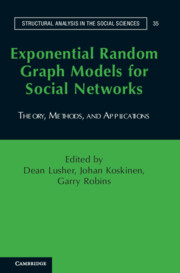Book contents
- Frontmatter
- Contents
- List of Figures
- List of Tables
- 1 Introduction
- Section I Rationale
- Section II Methods
- 6 Exponential Random Graph Model Fundamentals
- 7 Dependence Graphs and Sufficient Statistics
- 8 Social Selection, Dyadic Covariates, and Geospatial Effects
- 9 Autologistic Actor Attribute Models
- 10 Exponential Random Graph Model Extensions: Models for Multiple Networks and Bipartite Networks
- 11 Longitudinal Models
- 12 Simulation, Estimation, and Goodness of Fit
- 13 Illustrations: Simulation, Estimation, and Goodness of Fit
- Section III Applications
- Section IV Future
- References
- Index
- Name Index
9 - Autologistic Actor Attribute Models
Published online by Cambridge University Press: 05 April 2013
- Frontmatter
- Contents
- List of Figures
- List of Tables
- 1 Introduction
- Section I Rationale
- Section II Methods
- 6 Exponential Random Graph Model Fundamentals
- 7 Dependence Graphs and Sufficient Statistics
- 8 Social Selection, Dyadic Covariates, and Geospatial Effects
- 9 Autologistic Actor Attribute Models
- 10 Exponential Random Graph Model Extensions: Models for Multiple Networks and Bipartite Networks
- 11 Longitudinal Models
- 12 Simulation, Estimation, and Goodness of Fit
- 13 Illustrations: Simulation, Estimation, and Goodness of Fit
- Section III Applications
- Section IV Future
- References
- Index
- Name Index
Summary
Social Influence Models
So far, we focused on how a particular network structure may be a product of endogenous network processes (clustering, transitivity, popularity, etc.) and exogenous nodal and dyadic factors (gender, membership, geography, etc.). This chapter presents a class of cross-sectional network models that, rather than modeling network structure, allows us to understand how individual behavior may be constrained by position in a social network and by behavior of other actors in the network. For this purpose, we take network ties to be exogenous and model behaviors of the actors. We use the term “behavior” to refer to whatever nodal attribute we are interested in modeling, but this is understood to also cover, for example, attitudes and beliefs. The behavior is assumed to represent states and, at least in principle, may be liable to change, and possibly to change several times. However, the network ties are treated as exogenous and not changed by the attributes. In this chapter, we deal with binary attribute variables as measures of behavior, and if the variable is 1, we say that the actor displays the behavior, or that the behavior is present for that actor.
Social networks are often important to understand because social processes – such as diffusion of information, exercise of influence, and spread of disease – may be potentiated by network ties. There are relatively few models available for assessing the nature of this association between individual outcomes and network structure. An early instance of a general network approach to model social influence processes originates in network autocorrelation models (Doreian, 1982, 1989, 1990; Doreian, Teuter, & Wang, 1984; Erbring & Young, 1979; Leenders, 2002), based on work in spatial statistics (Anselin, 1982, 1984; Cliff & Ord, 1973, 1981; Ord, 1975). In this approach, network ties are taken to reflect dependencies among individual variables. An explicitly dynamic but deterministic theory of network-mediated social influence was developed by Friedkin (1998), who termed it the structural theory of social influence. This theory has its roots in the work of social psychologists and mathematicians, including DeGroot (1974), Erbring and Young (1979), French (1956), Friedkin and Johnsen (1997), Harary (1959), and others. Friedkin described it as “a mathematical formalization of the process of interpersonal influence that occurs in groups, affects persons’ attitudes and opinions on issues, and produces interpersonal agreement, including group consensus, from an initial state of disagreement” (2003, 89).
- Type
- Chapter
- Information
- Exponential Random Graph Models for Social NetworksTheory, Methods, and Applications, pp. 102 - 114Publisher: Cambridge University PressPrint publication year: 2012
- 9
- Cited by



